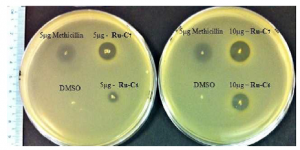Bacterial resistance to standard types of antibiotics is a growing problem in medical science. The most famous example is MRSA, which stands for Methicillin-resistant Staphylococcus aureus. This name refers to a bacterium which, through the process of natural selection, is now resistant to a class of antibiotics called beta-lactams (which include penicillin and the cephalosporins). MRSA is especially dangerous in environments like hospitals and nursing homes, where patients or residents with weakened immune systems are at greater risk of infection (compared with the general public). The Office for National Statistics reports that between 1993 and 2005, the number of deaths associated with MRSA rose from 51 to 1,652.1
Methods to try and fight this growing threat include increased sanitization of areas where people are most at risk of infection and screening patients for the bacteria upon hospital admission and separating carriers from non-carriers. In the scientific community, development of new compounds which are capable of killing MRSA and other antibiotic resistant bacteria is a highly important, ongoing research area.2
Metal complexes displaying biological activity have been widely reported; in particular complexes containing the metal ruthenium have been shown to display anti-cancer, anti-microbial and DNA binding abilities.3 In this paper, the authors synthesise several new ruthenium complexes and perform tests to assess their anti-microbial activity against MRSA.

Structure of ruthenium complexes synthesized
A ‘zone of clearance’ study pitted two of the new ruthenium complexes against methicillin in a test of how effectively each compound inhibited bacterial growth (see below). The ruthenium complexes were shown to have superior anti-MRSA activity when compared with methicillin, suggesting they could provide prolonged antibacterial activity when used as topical antibiotics.
‘Zone of clearance’ assay results
To read more, download the article now:
“Development of ruthenium(II) complexes as topical antibiotics against methicillin resistant Staphylococcus aureus”
W.-Y. Wong et al., Dalton Trans. 2014, DOI:10.1039/C3DT52879K
References:
1 UK Office for National Statistics, www.ons.gov.uk
2 P. A. Ashford, S. P. Bew, Chem. Soc. Rev., 2012, 41, 957
3 C. S. Allardyce, P. J. Dyson, Platinum Metals Rev., 2001, 45, 62
 |
Dr C. Liana Allen is currently a post-doctoral research associate in the group of Professor Scott Miller at Yale University, where she works on controlling the enantio- or regioselectivity of reactions using small peptide catalysts. Liana received her Ph.D. in organic chemistry at Bath University with Professor Jonathan Williams, where she worked on developing novel, efficient syntheses of amide bonds. |











